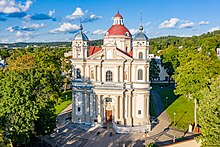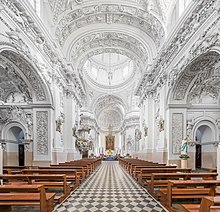Church of St. Peter and St. Paul, Vilnius
| St. Peter and St. Paul's Church Šv. apaštalų Petro ir Povilo bažnyčia | ||
|---|---|---|
Year consecrated 1701 | | |
| Status | Active | |
| Location | ||
| Location | Vilnius, Lithuania | |
| Geographic coordinates | 54°41′39″N 25°18′23″E / 54.69417°N 25.30639°E | |
| Architecture | ||
| Architect(s) | Jan Zaor Giovanni Battista Frediani | |
| Style | Baroque | |
| Funded by | Michał Kazimierz Pac | |
| Groundbreaking | 1668 | |
| Completed | 1701 | |
| Specifications | ||
| Direction of façade | Southwest | |
| Capacity | 980[1] | |
| Height (max) | 16.4 metres (54 ft)[2] | |
| Dome(s) | One | |
| Dome height (inner) | 39 metres (128 ft)[2] | |
| Spire(s) | Two | |
| Spire height | 24 metres (79 ft)[2] | |
| Materials | Clay bricks | |

The Church of St. Peter and St. Paul (
History
The foundation of the first church in this location is unknown, although, while digging the foundations for the present-day church, workers found a sculpture of an unknown knight.

During the
The church was finished by Pac's brother, Bishop of Samogitia
Architecture
Exterior

The church is located on a small hill near the
The double broken
Interior

St. Peter and St. Paul's is one of the most studied churches in Lithuania.[20] Its interior has over 2,000 different decor elements that creates a stunning atmosphere.[21] The main author of the decor plan is not known. It could be the founder Pac, monks of the Lateran, or Italian artists. No documents survive to explain the ideas behind the decorations, therefore various art historians attempted to find one central theme: Pac's life and Polish–Lithuanian relations, teachings of Saint Augustine, Baroque theater, etc.[20] Art historian Birutė Rūta Vitkauskienė identified several main themes of the decor: structure of the Church as proclaimed at the Council of Trent with Saint Peter as the founding rock, early Christian martyrs representing Pac's interest in knighthood and ladyship, themes relevant to the Canons Regular of the Lateran, and themes inherited from previous churches (painting of Blessed Virgin Mary of Mercy and altar of Five Wounds of Christ).[22] The decor combines a great variety of symbols, from local (patron of Vilnius Saint Christopher) to Italian saints (Fidelis of Como),[23] from specific saints to allegories of virtues. There are many decorative elements – floral (acanthus, sunflowers, rues, fruits), various objects (military weapons, household tools, liturgical implements, shells, ribbons), figures (puttos, angels, soldiers), fantastical creatures (demons, dragons, centaurs), Pac's coat of arms, masks making various expressions – but they are individualized, rarely repeating.[24] The architects and sculptors borrowed ideas from other churches in Poland (Saints Peter and Paul Church, Kraków, Sigismund's Chapel of Wawel Cathedral) and Italy (St. Peter's Basilica, Church of the Gesù).[23]
The main entrance is flanked by two large sculptures of
The central nave is decorated with evenly spaced sculptures of the twelve apostles.
Chapels and side altars

The church has one central
The transept has altars of two brotherhoods that were active in the church: Merciful Mother of God and Five Wounds of Christ.[12] These brotherhoods existed before the current church was built and, therefore, the imagery is inherited from the previous church.[6] The western (left) transept displays the painting of Blessed Virgin Mary of Mercy and two large Turkish war drums (timpano, 140 cm (55 in) in circumference)[31] that were seized from the Ottomans in the Battle of Khotyn of 11 November 1673 and granted to the church by its founder Michał Kazimierz Pac.[32] The transept ceiling has stucco reliefs from the life of Mary (with Visitation at the center) and crucifixion of Jesus.[33] The Rococo pulpit was installed in 1801–1804. Carved of wood in a shape of a boat, it is supported by two tritons from the bottom. It is decorated with gilded details, including reliefs of eagle, bull, lion, and angel which symbolize the Four Evangelists.[13]
Main altar

A noticeable feature is the missing main altar, which is known only from a description found in the inventory from 1766.
Four other paintings hang in the choir: another painting by Smuglewicz depicting
The ceiling of the apse is decorated with three stucco reliefs depicting the
The left corner between the transept and the choir has a sculpture of Jesus known as Jesus of Antakalnis. The sculpture is life-sized (185 cm (73 in)), made of hardwood, dressed in clothes of white silk and purple velvet, and has a wig of natural black hair.
Dome and ceilings

The dome's
The ceiling is decorated with five
Gallery
-
Close up of main portal with Pac's coat of arms in the middle
-
Danse Macabre, a reminder of the universality of death
-
St. Christopher carrying newborn Jesus.
-
View of the dome with the boat-shaped chandelier
-
Plague of 1710 in Vilnius
-
Pope John Paul II painting depicting him in Vilnius
-
Painting ofKanutas Ruseckasin 1848
-
Stamp of Lithuania; 1993; commemorative issue "church architecture - I"; St. Peter and St. Paul's Church, stamp with view and footprint.
See also
- Pažaislis Monastery – another Baroque masterpiece founded by a member of the Pac family
References
Citations
- ^ Čaplinskas (2010), p. 365
- ^ a b c d e Bielinis (1988), p. 78
- ^ a b c d e f Paknys (2011–2013)
- ^ "Vilniaus Šv. Apaštalų Petro ir Povilo bažnyčia". govilnius.lt (in Lithuanian). Retrieved 21 July 2020.
- ^ a b c d e f g h i Paknys (1998)
- ^ a b c d e Vaišvilaitė (2001), p. 30
- ^ a b c d "Kultūros vakaras: Maras Vilniuje. Vieno paveikslo istorijos pėdsakais" (in Lithuanian). Lietuvos dailės muziejus. 17 October 2001. Archived from the original on 19 April 2005. Retrieved 26 October 2014.
- ^ a b Kviklys (1985), p. 317
- ^ a b Vaišvilaitė (2001), p. 28
- ^ a b c Čerbulėnas (1994), p. 103
- ^ a b Čaplinskas (2010), p. 188
- ^ a b c d e f g h i j k l Vitkauskienė (2005)
- ^ a b c d e f g Bielinis (1988), p. 80
- ^ Kviklys (1985), p. 326
- ^ Bielinis (1988), p. 77
- ^ Kviklys (1985), p. 316
- ^ a b Čerbulėnas (1994), p. 104
- ^ Bielinis (1988), pp. 86–87
- ^ Bielinis (1988), p. 84
- ^ a b Vaišvilaitė (2001), p. 27
- ^ "Užburiantis baroko perlas Vilniuje – Šv. apaštalų Petro ir Povilo bažnyčia". Bernardinai.lt. 3 April 2013. Retrieved 3 April 2013.
- ^ Vaišvilaitė (2001), p. 34
- ^ a b c Samuolienė (2001), p. 35
- ^ Bielinis (1988), pp. 82–83
- ^ a b c Samuolienė (2001), p. 38
- ^ a b c d Vaišvilaitė (2001), p. 33
- ^ a b c Samuolienė (2001), p. 39
- ^ a b Bielinis (1988), p. 83
- ^ a b c d e f g h i j Vaišvilaitė (2001), p. 32
- ^ a b c d e f Bielinis (1988), p. 81
- ^ Bielinis (1988), p. 86
- ^ Kviklys (1985), p. 325
- ^ Samuolienė (2001), pp. 38–39
- ^ a b c d Bielinis (1988), p. 85
- ^ Bielinis (1988), pp. 81–82
- ^ a b c Vaišvilaitė (2001), p. 31
- ^ a b c d Račiūnaitė (2011–2013)
- ^ Paknys (2001), p. 43
- ^ Paknys (2001), pp. 44–45
- ^ Čerbulėnas (1994), p. 105
- ^ Paknys (2001), p. 49
- ^ Paknys (2001), pp. 43–44
- ^ Paknys (2001), pp. 43–51
- ^ Paliušytė (2005), p. 73
Sources
- Bielinis, Jonas; et al., eds. (1988). Lietuvos TSR istorijos ir kultūros paminklų sąvadas (in Lithuanian). Vol. 1. Vilnius: Vyriausioji enciklopedijų redakcija. OCLC 21449203.
- Čaplinskas, Antanas Rimvydas (2010). Vilniaus istorija: legendos ir tikrovė (in Lithuanian). Charibdė. ISBN 978-9955-739-21-0.
- Čerbulėnas, Klemensas; et al., eds. (1994). Lietuvos architektūros istorija: Nuo XVII a. pradžios iki XIX a. vidurio. Vol. II. Vilnius: Mokslo ir enciklopedijų leidykla. ISBN 5-420-00583-2.
- Kviklys, Bronius (1985). Lietuvos bažnyčios. V tomas: Vilniaus arkiviskupija, I dalis (in Lithuanian). Chicago, Illinois: Lithuanian Library Press. ISBN 0-932042-54-6.
- Paknys, Mindaugas (1998). "Vilniaus buvęs Laterano kanauninkų vienuolynas ir Šv. Petro ir Povilo bažnyčia". In Janonienė, Rūta; Klajumienė, Dalia (eds.). Lietuvos vienuolynai. Vadovas (in Lithuanian). Vilniaus dailės akademija. ISBN 9986-571-39-1. Archived from the originalon 25 February 2020. Retrieved 27 October 2014.
- Paknys, Mindaugas (2001). "Antakalnio šv. Petro ir Povilo bažnyčios freskų autorystės problema". Lietuvos Didžiosios Kunigaikštystės barokas: formos, įtakos, kryptys. Acta Academiae artium Vilnensis (in Lithuanian). Vol. 21. ISSN 1392-0316.
- Paknys, Mindaugas (2011–2013). "Ikonografinis pasakojimas Vilniaus Šv. Petro ir Povilo bažnyčioje". Orbis Lituaniae (in Lithuanian). Vilnius University. Archived from the original on 23 November 2020. Retrieved 26 October 2014.
- Paliušytė, Aistė, ed. (2005). Lietuvos dailininkų žodynas XVI–XVIII a. (in Lithuanian). Vilnius: Kultūros, meno ir istorijos institutas. ISBN 9986-638-60-7.
- Račiūnaitė, Tojana (2011–2013). "Antakalnio Jėzus Nazarietis – įstabi ispaniško baroko apraiška". Orbis Lituaniae (in Lithuanian). Vilnius University. Archived from the original on 23 November 2020. Retrieved 26 October 2014.
- Samuolienė, Sigita (2001). "Vilniaus Šv. Petro ir Povilo bažnyčios ikonografija". Lietuvos Didžiosios Kunigaikštystės barokas: formos, įtakos, kryptys. Acta Academiae artium Vilnensis (in Lithuanian). Vol. 21. ISSN 1392-0316.
- Vaišvilaitė, Irena (2001). "Vilniaus šventųjų apaštalų Petro ir Povilo bažnyčios dekoro programa". Lietuvos Didžiosios Kunigaikštystės barokas: formos, įtakos, kryptys. Acta Academiae artium Vilnensis (in Lithuanian). Vol. 21. ISSN 1392-0316. Archived from the originalon 3 November 2014.
- Vitkauskienė, Birutė Rūta (2005). "Šv. apaštalų Petro ir Pauliaus bažnyčia". Vilniaus arkivyskupijos kurija. Archived from the original on 5 November 2014. Retrieved 26 October 2014.








